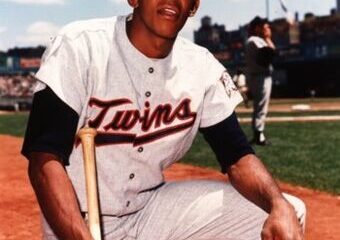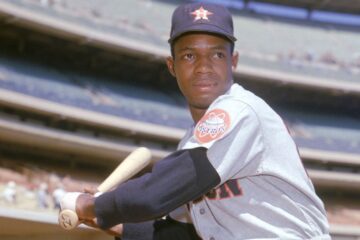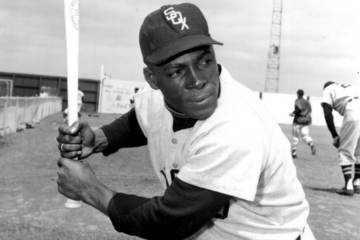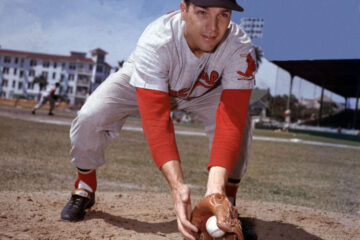The Hall of Fame Index: Where does Jackie Robinson rank among all-time second basemen?
We continue our series of debates addressed in Allen Barra’sClearing the Bases. This was published in 2002, so we have to cut him some considerable slack on some arguments. However, these arguments are fun, so we continue with the question of where Jackie Robinson ranks among second basemen. We will go through our usual battery of tests, but first I want to address the two major issues with his essay.
Of course, I say all this realizing my own book, The Hall of Fame Index Part II, will be out of date soon enough. However, he did two things that always irritate me. First, he began his essay with what we would call a straw man. In this case it was an unnamed critic of Robinson that didn’t think he would be in the Hall of Fame if he were white. Clearly, this is ridiculous and shouldn’t have even been a consideration. That notion is the proverbial knuckleball in the dirt. You don’t have to swing at it.
The second portion of the essay was a sound one. It raised the question of where he should rank among second baseman. He acknowledged that Rogers Hornsby was better, so he focused on comparing him with Nap Lajoie, Joe Morgan, Eddie Collins, and Charlie Gehringer. We will focus our attention on the first three. He chose Robinson. His reasoning was faulty. He considered him better at more skills. The problem is that he considered each skill to be of equal value. We know that’s not true. That will become clear as we go through our tests.
Career Value
| BWAR | FWAR | WS/5 | Total | |
| Eddie Collins | 123.9 | 120.5 | 114.8 | 359.2 |
| Nap Lajoie | 107.3 | 102.2 | 99.2 | 308.7 |
| Joe Morgan | 100.5 | 98.8 | 102.4 | 301.7 |
| Jackie Robinson | 61.7 | 57.2 | 51.4 | 170.3 |
Robinson didn’t make his debut until he was 28 years old. He did attend college and maybe could have played in the NFL if they also did not have a color barrier. Let’s assume he took a year to develop beyond college and set his debut at age 23. In his first five years he accumulated 35.7 BWAR. If we add that to the front end of his career, he might have gotten up to 97.4 BWAR. That puts him in the neighborhood of Morgan.
So, it isn’t ridiculous to put him in this group and we have to be careful about how we phrase our argument. Who is the greatest player on this list? It’s an impossible question to answer. Logic would dictate that improved athleticism, training, nutrition, and modern coaching would dictate that Morgan was the best since he is the closest to the modern game. Who was the most dominant is another question entirely.
We can measure dominance. Clearly, Collins enjoyed the most success and it really isn’t all that close. However, the question Barra wanted to know to who was the best when they were at their best. Fair question. So, let’s take a look at peak value.
Peak Value
| BWAR | FWAR | WS/5 | Total | Index | |
| Collins | 78.4 | 77.2 | 70.8 | 226.4 | 585.6 |
| Lajoie | 70.6 | 72.3 | 64.2 | 207.1 | 515.8 |
| Morgan | 67.8 | 67.0 | 64.2 | 199.0 | 500.7 |
| Robinson | 61.7 | 57.2 | 51.4 | 170.3 | 340.6 |
Yes, Robinson played ten seasons, but he didn’t debut until age 28. So, you could replace those last three seasons with three better seasons on the front end and maybe get him in the neighborhood of Lajoie and Morgan. Still, it is difficult to imagine him getting to Collins country. Still, Barra says he would pick Robinson over Collins. Why is that? Well, Robinson was a better power hitter (true), baserunner (true), and fielder (also true). The problem is that a majority of a player’s value takes place in the batter’s box.
The ability to steal first base is the single most valuable skill. Therein lies the issue with focusing on the five tools. Not every tool is valuable. So, to say that Robinson is better at more of them is not necessarily irrelevant, but it’s not an overwhelming argument for him either. This becomes clear when we look at the offensive numbers.
Offensive Numbers
| OPS+ | Rbaser | OW% | wOBA | |
| Lajoie | 150 | -11 | .758 | .401 |
| Collins | 142 | 39 | .715 | .409 |
| Morgan | 132 | 80 | .702 | .372 |
| Robinson | 132 | 32 | .684 | .406 |
Let’s remember a couple of things. Lajoie and Collins played during the Dead Ball Era, so their wOBA are artificially low in comparison to Robinson. Barra uses this as points in his favor by pointing out that Collins did not have the slugging ability of Robinson. That might be true, but it is also possible Collins would have demonstrated more power had he played in a different time.
The live ball era didn’t begin until he was in his mid-thirties, so the crack that he wasn’t much of a power hitter in the 1920s is not that compelling. However, let’s compare the two side by side when we separate OBP and isolated power as compared to the league over the course of both player’s careers.
| OBP | LGOBP | OBP+ | ISO | LGISO | ISO+ | |
| Collins | .424 | .342 | 124 | .096 | .093 | 103 |
| Robinson | .409 | .347 | 118 | .162 | .143 | 113 |
So, it is true that Collins did not have the raw power of Robinson even as it is compared to league averages, the gap is not as large as we would have thought. It is close to the difference between their collective on base percentages. Since Collins had a higher career batting average, the slugging percentages themselves end up being closer. Batting averages are antiquated, but they still have some value.
Fielding Numbers
| Rfield | DWAR | TZ2B | DWS/5 | |
| Lajoie | 83 | 10.1 | 79 | 19.2 |
| Robinson | 81 | 10.1 | 50 | 11.0 |
| Collins | 35 | 8.1 | 40 | 21.7 |
| Morgan | -48 | 3.8 | -43 | 18.4 |
Fielding analysis is unique. There is some difference between greatness and value. Given that he played for only ten years, you could definitely argue that Robinson was the best fielder amongst this group. After all, Lajoie toiled for more than ten seasons, so on a per season basis Robinson was better. Yet, you can be average (or above average in Collins case) and still be quite valuable.
It’s like how geologists describe the process of erosion. You could have a sudden gush of water pressure come and go, but a steady stream of water over a very long period of time will do the trick. Naturally, if you give Robinson five years on the front end then that difference is negated some, but Collins still had longevity that only Morgan came close to matching.
He played 102 games in 1908 and did so in almost every season (save 1918) until he played 106 games at age 39 in 1926. He spent the next four seasons as a part-time player for the Athletics. His last two seasons amounted to nothing more than cameos. However, his 2826 games dwarfs Robinson and therefore he has more offensive and fielding value just due to the volume of performance.
Playoff Performance
| PA | SLASH | HR | Runs | RBI | SB | |
| Morgan | 222 | .182/.323/.348 | 5 | 26 | 13 | 15 |
| Robinson | 160 | .234/.335/.343 | 2 | 22 | 12 | 6 |
| Collins | 147 | .328/.381/.414 | 0 | 20 | 11 | 14 |
| Lajoie | — | —/—/— | — | — | — | — |
Collins had a prominent place on the dynastic Athletics that dominated the American League in the early 1910s. He also played with the White Sox when they won the 1917 World Series. Obviously, the 1919 World Series will be a black mark on his resume, but we also know that wasn’t really his fault. He also won another World Series with the Athletics in 1929, but he really didn’t contribute much to that one.
Juxtapose that with Robinson and we see a definite separation. The Dodgers won only one World Series during his time in Brooklyn and frequently went up against the Yankees and lost. His numbers weren’t terrible, but you could imagine that if they were on par with his regular season numbers his teams might have fared better.
Morgan had the benefit of playing in a league championship series in addition to the World Series. His teams famously won the 1975 and 1976 World Series. Clearly, Morgan’s numbers indicate that he didn’t have much to contribute to those wins. However, some consider the Big Red Machine as the greatest team of the 20thcentury. Morgan played as big a role on that team as any.
It’s fair to ask what this all means. I typically don’t like small sample sizes. 200 plate appearances amount to approximately two months of action. Postseason performance is important, but it cannot outweigh 10 years, 15 years, or 20 years of performance. At best, we could consider it a tiebreaker and if we were to break any ties we would clearly see that going Collins’ way.
BWAR MVP Points
| Top 10 | Top 5 | MVP | PTS | |
| Lajoie | 5 | 2 | 5 | 75 |
| Collins | 5 | 9 | 1 | 70 |
| Morgan | 2 | 2 | 4 | 56 |
| Robinson | 1 | 2 | 3 | 43 |
When I was a kid, Beckett Baseball released a monthly magazine that charted the value of baseball cards and published articles. My love of statistics came from memorizing the numbers on the backs of baseball cards and reading those monthly magazines. One of the articles provided extensive evidence that the prime of most players’ careers comes when they turn 27. Obviously, every player is different, but for the most part that was a good barometer.
Robinson didn’t make his debut until he was 28. I’ve said it before, but we need to let that sink in. If he had a normal career arc he might have won another MVP award and might have deserved a couple more. That would put him in Lajoie territory. That’s obviously very different from Collins. Collins was one of the ten best players in the league 15 times. He had 18 seasons where he played 100 or more games. That is a remarkable level of consistency.
For a pre-teen card collector, the presence of bold ink on the backs of those cards meant a lot more than consistently very good performance. Collins led the league in runs scored three times. He led in steals four times and walks once. That’s it. Lajoie won five batting titles, four slugging titles, led in RBI three times, and paced the American League four times in hits. I could go on and on. He obviously trumps Collins in a black ink test. Robinson didn’t fare well comparatively either. Fortunately, we are more sophisticated now in our analysis. There’s no defensible way to say Robinson was more valuable than Collins. We could put Robinson in the same neighborhood as Lajoie and Morgan. That makes him a top five all-time second baseman. I think that’s good enough.





